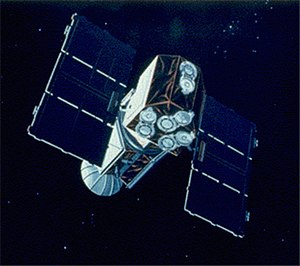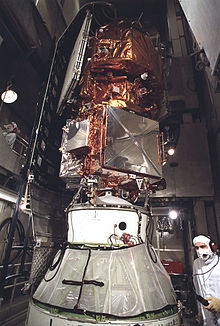Extreme Ultraviolet Explorer
| EUVE (Explorer 67) | |
|---|---|

|
|
| Type: | Space telescope |
| Country: |
|
| Operator: |
|
| COSPAR-ID : | 1992-031A |
| Mission dates | |
| Dimensions: | 3275 kg |
| Begin: | June 7, 1992, 16:40 UTC |
| Starting place: | Cape Canaveral , LC-17A |
| Launcher: | Delta-6920-10 D210 |
| Status: | out of service from January 26, 2001, burned up on January 30, 2002 |
| Orbit data | |
| Rotation time : | 95 min |
| Orbit inclination : | 28.4 ° |
| Apogee height : | 524 km |
| Perigee height : | 510 km |
The Extreme Ultraviolet Explorer (EUVE) (or Explorer 67 ) was a space telescope for ultraviolet astronomy . With instruments for UV radiation between 7 and 76 nm wavelength, EUVE was the first satellite mission specifically for the short-wave ultraviolet range.
EUVE is a development by NASA and the Space Sciences Laboratory at the University of California, Berkeley . EUVE was launched from Cape Canaveral on June 7, 1992 with a Delta II rocket . Scientific operations ended on January 26, 2001, and the satellite re-entered the earth's atmosphere on January 30, 2002.
EUVE had three experiments, each with one or more small Wolter telescopes and using microchannel plates as detectors:
- A camera with a 5 ° field of view with two filters for 4.4–22 nm and 14–36 nm.
- A camera with a 4 ° field of view with two filters for 52–75 nm and 40–60 nm.
- A combination of camera and spectrometer for the wavelength range 7–76 nm, for observing individual objects.
The specialty of the extreme ultraviolet range ( EUV ) for astronomical applications is that this range of electromagnetic radiation is swallowed up by even small amounts of atomic hydrogen in the interstellar matter . Due to the irregular structure of the interstellar matter with wide ionized areas, some mainly close and hot stars can still be observed in the EUV. Some active galactic nuclei can also be examined. In the first six months of the mission, EUV scanned the entire sky for sources of short-wave ultraviolet radiation and compiled a catalog of 700 objects. After that, mainly sensitive observations of individual objects were obtained.
Web links
- EUVE page at the Space Sciences Lab (English)
- EUVE page at NASA-GSFC (English)
- EUVE in the Encyclopedia Astronautica (English)
- EUVE in the NSSDCA Master Catalog (English)
Individual evidence
- ↑ Orbit data according to EUVE in the Encyclopedia Astronautica , accessed on August 13, 2012 (English).

